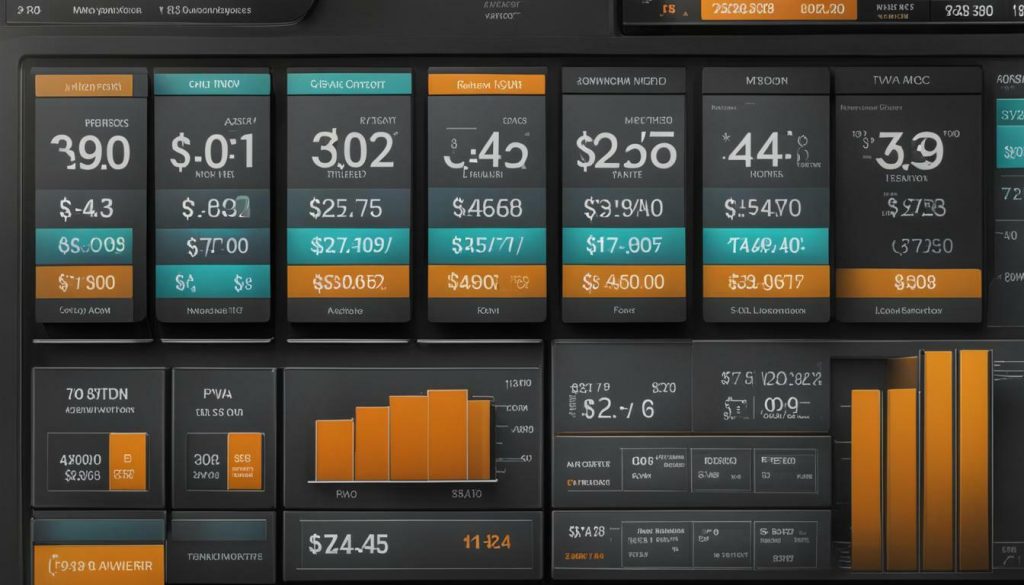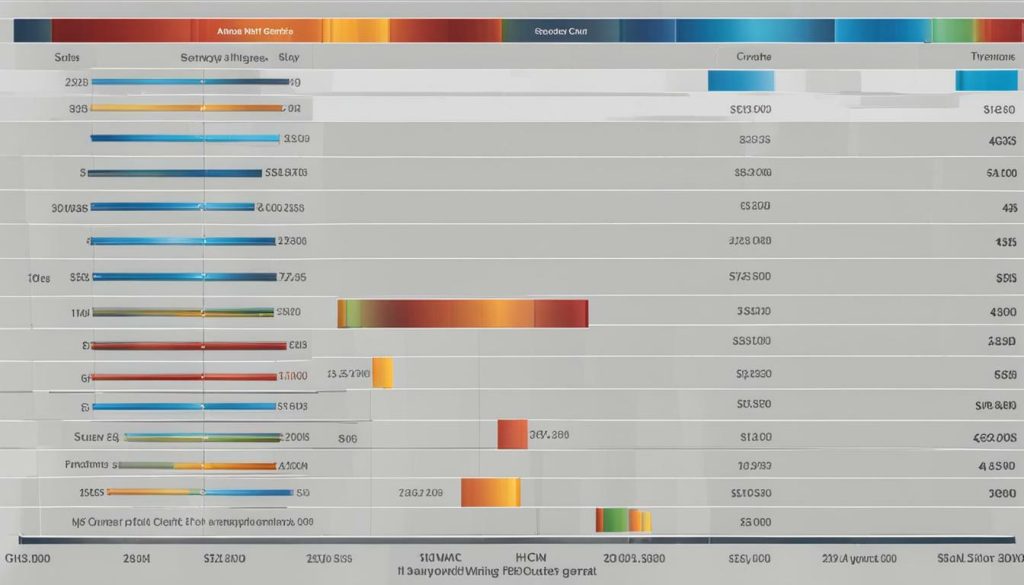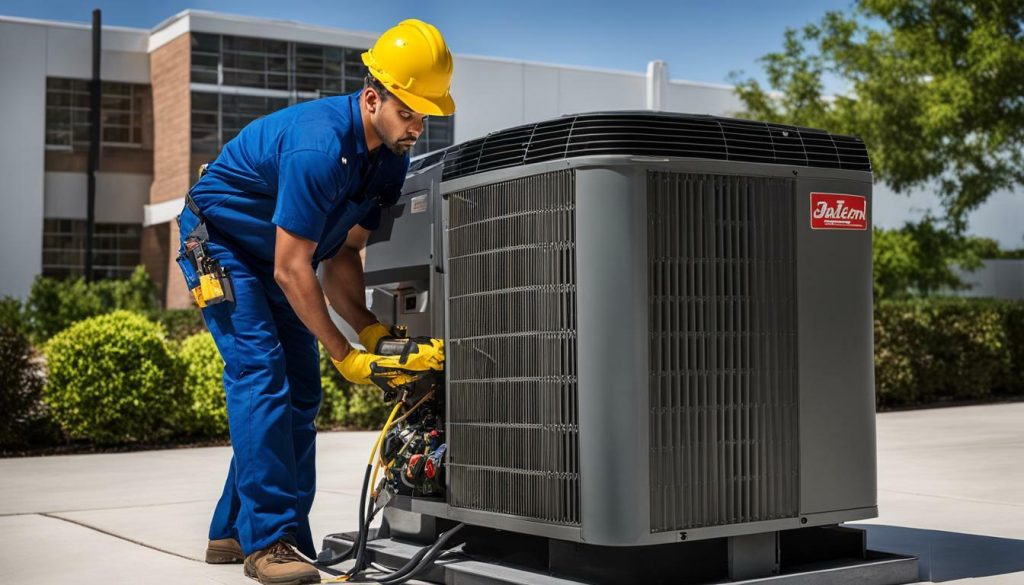Bidding HVAC jobs accurately and profitably is crucial for the success of HVAC contractors. By implementing effective strategies and following a structured bidding process, you can increase your chances of winning contracts and maximizing profits.
Bidding HVAC jobs requires careful consideration of various factors to ensure accuracy and profitability. It begins with choosing the right projects based on factors such as location and your company’s expertise. Thoroughly reviewing bid documents and performing a quantity takeoff are essential steps that help in estimating material and equipment requirements accurately.
Obtaining quotes from suppliers and estimating labor costs play a significant role in bidding HVAC jobs. Gathering competitive quotes and accurately assessing labor requirements contribute to an accurate bid. Additionally, including overhead and profit is crucial for ensuring profitability and covering operational expenses.
Utilizing electronic takeoff tools and estimation software can enhance accuracy and efficiency in the bidding process. These tools streamline the management of bids, helping you save time and improve accuracy in estimating project costs.
Tracking bidding results and analyzing competitors’ pricing can provide valuable insights for strategizing your bids. Monitoring your bidding performance and staying informed about market trends can give you a competitive edge.
Avoiding price cutting is essential in maintaining the value of your work. Instead, confidently showcasing your expertise and sticking to fair prices can help you win contracts and establish a reputation as a reliable HVAC contractor.
Bidding HVAC jobs accurately and profitably requires a systematic approach that takes into account various factors. By following these strategies and staying informed about industry best practices, you can increase your chances of success in bidding HVAC jobs.
Key Takeaways:
- Choose HVAC projects based on factors like location and expertise.
- Thoroughly review bid documents and perform a quantity takeoff for accurate estimation.
- Obtain quotes from suppliers and estimate labor costs to ensure an accurate bid.
- Include overhead and profit to ensure profitability and cover operational expenses.
- Utilize electronic takeoff tools and estimation software for accuracy and efficiency.
Choosing the Right HVAC Projects for Bidding
Before diving into the bidding process, it is essential to carefully evaluate and choose the HVAC projects that are the best fit for your company. By selecting projects based on factors like location and your company’s expertise, you can increase your chances of success.
When considering which projects to bid on, take into account the location of the project. It is often more cost-effective to bid on projects that are in close proximity to your business. This not only saves on transportation costs but also allows for easier project management and quicker response times.
Another important factor to consider is your company’s expertise. Look for projects that align with your team’s skills and experience. By specializing in specific types of HVAC projects, you can maximize your efficiency and deliver high-quality work. This expertise will differentiate your bids and increase your chances of winning contracts.
Table 1: Project Evaluation Criteria
| Location | Expertise | Project Size |
|---|---|---|
| Close proximity to your business | Projects aligned with your team’s skills and experience | Projects that match your capacity and resources |
| Easier project management and reduced transportation costs | Efficient use of your team’s specialized knowledge | Optimal allocation of resources |
By carefully evaluating and selecting HVAC projects that align with your company’s strengths and resources, you can enhance your bidding strategy and increase your chances of securing profitable contracts. Remember, choosing the right projects sets the foundation for a successful bidding process.

Reviewing Bid Documents and Performing Quantity Takeoff
To bid on HVAC projects accurately, you must start by diligently reviewing bid documents and performing a comprehensive quantity takeoff. These steps help you understand the project requirements and estimate the materials and equipment needed.
When reviewing bid documents, pay close attention to the project specifications, drawings, and any additional instructions provided. Take note of the scope of work, deadlines, and any special requirements that may impact your bid. This thorough review ensures that you have a clear understanding of the project and can accurately assess the resources and costs involved.
Performing a quantity takeoff is the next crucial step in the bidding process. This involves quantifying the materials, equipment, and labor required for the project. Carefully analyze the drawings and specifications to determine the quantities needed for each component. Consider factors like the square footage of the space, number of units or fixtures, and any specialized equipment required.
Once you have quantified the materials and equipment, you can prepare a comprehensive list and estimate their costs. This allows you to accurately calculate the overall project cost and determine a competitive bid price. Accuracy in estimating quantities and costs is key to ensuring that your bid is both accurate and profitable.

Sample Quantity Takeoff Table:
The table below provides an example of how you can structure your quantity takeoff table:
| Item | Quantity | Unit |
|---|---|---|
| Ductwork | 500 feet | Linear feet |
| Grilles and Registers | 50 pieces | Pieces |
| Condensing Unit | 2 units | Each |
| Air Handling Unit | 1 unit | Each |
| Insulation | 1000 sq ft | Square feet |
By diligently reviewing bid documents and performing a thorough quantity takeoff, you can accurately estimate the materials and equipment needed for your HVAC projects. This ensures that your bids are precise, competitive, and profitable.
Obtaining Supplier Quotes and Estimating Labor Costs
To create accurate bids, it is crucial to obtain competitive quotes from reliable suppliers and estimate labor costs effectively. This section will guide you through the process of gathering quotes and estimating labor to ensure accurate cost estimation.
When obtaining supplier quotes, it is important to reach out to multiple suppliers to ensure you are getting the best prices for materials and equipment. Look for suppliers that offer quality products and have a good reputation in the industry. Request itemized quotes that clearly outline the cost of each component, allowing you to compare and choose the most cost-effective options.
Estimating labor costs requires careful consideration of the scope of work and the expertise required for the project. Break down the project into specific tasks and estimate the time it will take to complete each task. Consider the skill level and experience of the laborers, as well as any additional factors that may affect the labor costs, such as overtime or specialized equipment.
| Component | Supplier | Price |
|---|---|---|
| Condenser Unit | Supplier A | $500 |
| Ductwork | Supplier B | $800 |
| Thermostat | Supplier C | $150 |
By considering both supplier quotes and labor costs, you will be able to accurately estimate the total cost of the HVAC project. This will not only help ensure that your bid is competitive, but also ensure that your business remains profitable. Remember to regularly review your suppliers and labor costs to stay up-to-date with market fluctuations and maintain accurate bidding practices.

Adding Overhead and Profit to Bid
Adding overhead and profit to your HVAC bid is essential for covering operational expenses and maximizing profitability. In this section, you will learn how to accurately calculate and incorporate overhead and profit in your bids.
First, let’s break down the concept of overhead. Overhead costs are the indirect expenses incurred during the course of a project, such as rent, utilities, insurance, and administrative fees. To determine your overhead costs, calculate the total annual expenses for these items and divide it by the total number of projects you expect to bid on in a year. This will give you an estimate of the overhead cost per project.
Profit, on the other hand, is the amount you add to your bid to ensure a return on investment and account for the risks involved in the project. It is crucial to strike a balance between being competitive in your pricing and ensuring a reasonable profit margin. A common approach is to add a percentage of profit to the total project cost. This percentage may vary depending on factors such as project size, complexity, and market conditions.
Once you have determined your overhead and profit, it’s time to incorporate them into your bid. Calculate the total project cost by adding the direct costs, which include materials, labor, and subcontractors, to the overhead and profit. Present this total as the bid amount to the client. Remember to clearly outline and justify your overhead and profit in the bid proposal to add transparency and build trust with potential clients.
| Elements | Formula |
|---|---|
| Overhead | Total annual overhead expenses ÷ Total number of projects bid on per year |
| Profit | (Total project cost × Desired profit percentage) ÷ 100 |
| Total Project Cost | Direct costs (materials, labor, subcontractors) + Overhead + Profit |
Example:
Let’s say your total annual overhead expenses amount to $50,000, and you plan to bid on 20 HVAC projects in a year. Your overhead cost per project would be $2,500 ($50,000 ÷ 20). Now, if you want to achieve a 15% profit margin on a project with a total cost of $100,000, your profit would be $15,000 (($100,000 × 15) ÷ 100). The total project cost, including direct costs, overhead, and profit, would come to $117,500 ( $100,000 + $2,500 + $15,000).

By accurately calculating and incorporating overhead and profit in your bids, you can ensure that your HVAC projects are not only financially viable but also set you up for long-term profitability. Remember to regularly review and adjust your overhead and profit calculations to stay competitive and account for any changes in market conditions or project requirements.
Utilizing Electronic Takeoff Tools and Estimation Software
To streamline your bidding process and improve accuracy, consider utilizing electronic takeoff tools and estimation software. This section will explore the benefits of these tools and provide tips on how to leverage them effectively.
Electronic takeoff tools are essential for accurately measuring and quantifying materials required for an HVAC project. These tools allow you to digitally measure lengths, areas, and volumes directly from project drawings, eliminating the need for manual calculations and reducing errors. By automating the takeoff process, you can save time and ensure precise material estimations.
Estimation software complements electronic takeoff tools by providing a centralized platform for organizing and analyzing project data. With estimation software, you can input the quantities obtained from your takeoff and easily generate cost estimates based on current material and labor prices. This software also allows you to create customizable templates, streamline your bidding workflow, and track revisions, ensuring consistency and efficiency in your estimates.
Benefits of utilizing electronic takeoff tools and estimation software:
- Improved accuracy and reduced errors in material estimations
- Time savings through automation of manual calculations
- Enhanced organization and analysis of project data
- Consistency and efficiency in bid preparation
- Customizable templates for streamlined workflow
- Real-time tracking of revisions and updates
To fully leverage these tools, it is essential to invest time in learning their features and functionalities. Familiarize yourself with the software’s measurement tools, cost databases, and reporting capabilities. Additionally, take advantage of any training resources or tutorials provided by the software vendor.

| Best Practices for Utilizing Electronic Takeoff Tools and Estimation Software |
|---|
| 1. Take the time to accurately set up the software, including configuring measurement units and importing cost databases specific to your region. |
| 2. Ensure your project drawings are of high quality and properly scaled to achieve accurate measurements. |
| 3. Regularly update your cost databases to reflect current market prices for materials and labor. |
| 4. Collaborate with your team by utilizing cloud-based platforms that allow for seamless sharing and version control of project data. |
| 5. Practice validating your estimates against past projects to refine and improve your accuracy over time. |
Tracking Bidding Results and Analyzing Competitors’ Pricing
To continuously improve your bidding strategy, it is crucial to track your bidding results and analyze your competitors’ pricing. In this section, you will discover how to effectively monitor your performance and gain insights from your competitors’ pricing.
Tracking your bidding results allows you to assess the effectiveness of your strategies and make data-driven decisions. Maintain a record of the projects you bid on, the bid amounts, and the outcomes. By analyzing this information, you can identify patterns and trends that can inform future bidding decisions. Keep track of the projects you win and lose, as well as the reasons behind each outcome. This data will help you understand which types of projects are more profitable for your business and which areas need improvement.
Additionally, analyzing your competitors’ pricing provides valuable insights into the market and helps you position your bids effectively. Research and compare the pricing strategies of your competitors, paying attention to their pricing structures, profit margins, and any unique value propositions they offer. This information can help you determine competitive pricing ranges and differentiate your bids based on unique selling points.
| Benefits of Tracking Bidding Results and Analyzing Competitors’ Pricing | |
|---|---|
| 1. Improved bidding strategy | By analyzing bidding results, you can identify areas for improvement and refine your strategies accordingly. |
| 2. Data-driven decision making | Tracking bidding results allows for data-driven decision making based on past performance and outcomes. |
| 3. Better understanding of profitability | By analyzing bidding outcomes, you can gain insights into the types of projects that are more profitable for your business. |
| 4. Competitive advantage | Understanding your competitors’ pricing helps you position your bids strategically and stand out in the market. |
By tracking bidding results and analyzing competitors’ pricing, you can optimize your bidding strategy and increase your chances of winning profitable HVAC projects. Remember to consistently review and update your data to stay informed about market trends and adapt your strategy accordingly.

Avoiding Price Cutting and Showcasing Expertise Confidently
While it may be tempting to cut prices to win contracts, it is important to avoid this practice as it undermines the value of your work. Instead, this section will guide you on how to maintain fair prices while confidently showcasing your expertise to win HVAC job contracts. By following these strategies, you can position yourself as a trusted and reliable contractor in the industry.
To start, it is crucial to accurately estimate the costs involved in completing a project. This includes considering the material and equipment requirements, as well as the labor costs. By conducting thorough research and obtaining quotes from suppliers, you can ensure that your pricing is fair and competitive. Remember to factor in any overhead costs you may have, such as insurance, permits, and administrative expenses.
In addition to pricing, it is equally important to communicate your expertise confidently. Highlight your experience, certifications, and successful past projects to demonstrate your capabilities. Utilizing electronic takeoff tools and estimation software can help you create professional and detailed bids that showcase your professionalism.

Furthermore, establishing strong relationships with customers and emphasizing the value you provide can help you differentiate yourself from competitors. Offering exceptional customer service, providing timely and accurate estimates, and maintaining open communication throughout the bidding process can go a long way in building trust and confidence with potential clients.
By avoiding price cutting and confidently showcasing your expertise, you can position yourself as a reputable HVAC contractor and increase your chances of winning profitable contracts. Remember to always strive for fair pricing, exceptional service, and clear communication to establish long-term success in the industry.
| Tips to Avoid Price Cutting and Showcase Expertise: |
|---|
| 1. Thoroughly research and accurately estimate project costs. |
| 2. Obtain competitive quotes from suppliers and consider all overhead expenses. |
| 3. Highlight your expertise, certifications, and successful past projects. |
| 4. Utilize electronic takeoff tools and estimation software for professional bids. |
| 5. Offer exceptional customer service and communicate value to clients. |
Conclusion
Bidding HVAC jobs accurately and profitably requires careful consideration of various factors. By implementing the strategies outlined in this guide, you can improve your chances of winning contracts, maximizing profits, and ensuring success in the HVAC industry.
First and foremost, choosing the right projects to bid on is crucial. Consider factors such as location and your company’s expertise to ensure that you are targeting projects that align with your strengths. This will increase your chances of delivering high-quality work and satisfying your clients.
Another key aspect of accurate bidding is thoroughly reviewing bid documents and performing a quantity takeoff. This step allows you to estimate the material and equipment requirements accurately, helping you avoid costly mistakes in the long run.
Obtaining quotes from suppliers and accurately estimating labor costs are essential in developing a comprehensive bid. Be diligent in gathering competitive quotes and consider all aspects of labor, including any specialized skills required, to ensure that your bid reflects the true cost of the project.
Adding overhead and profit to your bid is crucial for ensuring profitability. It is essential to cover your operational expenses and provide a fair margin for your business. Striking the right balance will allow you to maintain competitiveness while also ensuring that your company remains financially healthy.
Utilizing electronic takeoff tools and estimation software can significantly streamline the bidding process, enhancing accuracy and efficiency. These tools can help you manage the complexities of estimating and ensure that your bids are precise and professional.
Additionally, tracking your bidding results and analyzing competitors’ pricing can provide valuable insights for future bids. This information allows you to evaluate your performance, identify areas for improvement, and develop effective strategies for winning contracts.
It is important to avoid price cutting as it can undermine the value of your work and lead to unsustainable business practices. Instead, maintain fair prices that reflect the quality of your services and confidently showcase your expertise. Demonstrating your capabilities and expertise will instill confidence in potential clients, increasing your chances of securing contracts.
By following these strategies, you can navigate the HVAC job bidding process with confidence. Remember to carefully consider all the factors involved, use technology to your advantage, and maintain integrity in your pricing. With these principles in mind, you can position your business for success in the competitive HVAC industry.
FAQ
What factors should I consider when choosing HVAC projects to bid on?
Factors such as location and expertise should be considered when evaluating potential HVAC projects for bidding.
Why is it important to review bid documents and perform a quantity takeoff?
Thoroughly reviewing bid documents and performing a quantity takeoff helps in accurately estimating material and equipment requirements for HVAC projects.
How can I obtain competitive supplier quotes and estimate labor costs?
Gathering competitive quotes from suppliers and accurately estimating labor costs are important considerations in the HVAC bidding process.
Why is it crucial to add overhead and profit to my bid?
Including overhead and profit in your bid ensures that operational expenses are covered and profitability is maintained in HVAC projects.
What are the advantages of utilizing electronic takeoff tools and estimation software?
Electronic takeoff tools and estimation software streamline the HVAC bid management process, increasing accuracy and efficiency.
How can I track bidding results and analyze competitors’ pricing?
Tracking bidding results and analyzing competitors’ pricing helps in monitoring your bidding performance and staying informed about market trends.
Should I cut prices in order to win HVAC contracts?
Cutting prices undermines the value of your work. It is recommended to maintain fair prices and confidently showcase your expertise to win contracts.





0 Comments